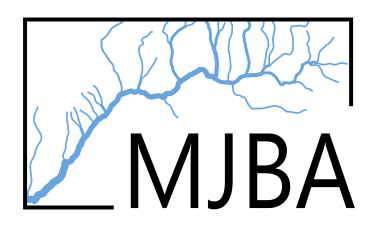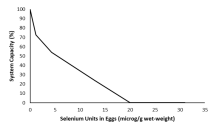Selenium and Athabasca Rainbow Trout
mbakken
View all records in the stressor response library
Species Common Name
Athabasca Rainbow Trout
Latin Name (Genus species)
Oncorhynchus mykiss
Stressor Name
Selenium
Specific Stressor Metric
Selenium in eggs
Stressor Units
µg/g egg wet weight
Vital Rate (Process)
Survival
Geography
Alberta foothills watersheds, excluding National Parks
Detailed SR Function Description
Selenium is a naturally occurring element, necessary in trace amounts for metabolic processes but toxic at high concentrations (Frost and Lish 1975; Wang and Gao 2001). A variety of natural and human causes can lead to increases in selenium in fish, including open-pit mining that exposes limestone, increases in sedimentation and run-off, and atmospheric deposition from coal-burning power plants (Barceloux 1999; Lemly 2004). In salmonid fish, observed individual-level effects of selenium toxicity include a decrease in egg incubation time, hatch rate, fry survival, juvenile survival, and juvenile growth (e.g. Hodson et al. 1980, Hamilton et al. 1986, Hamilton et al. 1990). High concentrations of selenium have been detected in east slopes streams in the range of Athabasca Rainbow Trout, apparently caused by open-pit coal mining (Palace et al. 2004). Extensive reviews of selenium in Alberta fishes and waters are found in Fortin (2010) and Pilgrim (2012).
At a population level, decreased juvenile survival could result in decreased population size. However, to date most studies have focused on individual-level effects, but results have rarely been extrapolated to the population. The selenium stressor-response curves for Athabasca rainbow trout were derived based on the research of Pilgrim (2012). Units of selenium concentration that best described population-level effects on Rainbow Trout were egg Se (microgram/gram wet-weight) (Figure 1).
Although the ecotoxicology of elevated selenium levels in warm and cold-water fish has been studied by numerous authors, the effects of selenium contamination remain somewhat controversial (Kennedy et al. 2000, Sappington 2002, Hardy et al. 2010). Therefore, as new population-level literature becomes available, the dose-response curve should be updated.
At a population level, decreased juvenile survival could result in decreased population size. However, to date most studies have focused on individual-level effects, but results have rarely been extrapolated to the population. The selenium stressor-response curves for Athabasca rainbow trout were derived based on the research of Pilgrim (2012). Units of selenium concentration that best described population-level effects on Rainbow Trout were egg Se (microgram/gram wet-weight) (Figure 1).
Although the ecotoxicology of elevated selenium levels in warm and cold-water fish has been studied by numerous authors, the effects of selenium contamination remain somewhat controversial (Kennedy et al. 2000, Sappington 2002, Hardy et al. 2010). Therefore, as new population-level literature becomes available, the dose-response curve should be updated.
Function Derivation
Experimental data
Transferability of Function
This function was created for Athabasca Rainbow Trout but was based on laboratory experiments on hatchery Rainbow Trout. It should be used in other Rainbow Trout systems with caution.
Source of stressor Data
Athabasca Rainbow Trout and Westslope Cutthroat Trout values at this time are set to 0 but it is our expectation that monitoring from industry will have taken place and whole-body tissue concentrations would be available.
Function Type
continuous
Stressor Scale
linear
References Cited
Government of Alberta. 2024. Selenium stressor-response function for Athabasca Rainbow Trout and Westslope Cutthroat Trout. Environment and Protected Area Native Trout Cumulative Effects Model.
Barceloux, D.G. 1999. Selenium. Clinical Toxicology 37: 145-172.
Fortin, B.L. 2010. Selenium dynamics in Canadian Rocky Mountain lakes. M.Sc. thesis, Department of Biological Sciences, University of Alberta. Edmonton, Alberta. 130 pp.
Frost, D.V., and P.M. Lish. 1975. Selenium in biology. Annual Review of Pharmacology 15: 259-284.
Hamilton, S.J., and R.H. Wiedmeyer. 1990. Concentrations of boron, molybdenum, and selenium in Chinook salmon. Transactions of the American Fisheries Society 119:500–510.
Hamilton, S.J., Palmisano, A.N., Wedemeyer, G.A., and W.T. Yasutake. 1986. Impacts of selenium on early life stages and smoltification of fall Chinook salmon. Transactions of North American Wildlife Natural Resources Conference 51:343-356.
Hardy, R.W., L.L. Oram, and G. Moller. 2010. Effects of dietary selenomethionine on cutthroat trout (Oncorhynchus clarki bouvieri) growth and reproductive performance over a life cycle. Archives of Environmental Contamination and Toxicology 58: 237-245.
Hodson, P.V., D.J. Spry, and B.R. Blunt. 1980. Effects on rainbow trout (Salmo gairdneri) of a chronic exposure to waterborne selenium. Canadian Journal Fisheries and Aquatic Science 37:233–240.
Kennedy, C.J., L.E. McDonald, R. Loveridge, and M.M. Strosher. 2000. The effect of bioaccumulated selenium on mortalities and deformities in the eggs, larvae, and fry of a wild population of cutthroat trout (Oncorhynchus clarkii lewisi). Archives of Environmental Contamination and Toxicology 39: 46-52.
Barceloux, D.G. 1999. Selenium. Clinical Toxicology 37: 145-172.
Fortin, B.L. 2010. Selenium dynamics in Canadian Rocky Mountain lakes. M.Sc. thesis, Department of Biological Sciences, University of Alberta. Edmonton, Alberta. 130 pp.
Frost, D.V., and P.M. Lish. 1975. Selenium in biology. Annual Review of Pharmacology 15: 259-284.
Hamilton, S.J., and R.H. Wiedmeyer. 1990. Concentrations of boron, molybdenum, and selenium in Chinook salmon. Transactions of the American Fisheries Society 119:500–510.
Hamilton, S.J., Palmisano, A.N., Wedemeyer, G.A., and W.T. Yasutake. 1986. Impacts of selenium on early life stages and smoltification of fall Chinook salmon. Transactions of North American Wildlife Natural Resources Conference 51:343-356.
Hardy, R.W., L.L. Oram, and G. Moller. 2010. Effects of dietary selenomethionine on cutthroat trout (Oncorhynchus clarki bouvieri) growth and reproductive performance over a life cycle. Archives of Environmental Contamination and Toxicology 58: 237-245.
Hodson, P.V., D.J. Spry, and B.R. Blunt. 1980. Effects on rainbow trout (Salmo gairdneri) of a chronic exposure to waterborne selenium. Canadian Journal Fisheries and Aquatic Science 37:233–240.
Kennedy, C.J., L.E. McDonald, R. Loveridge, and M.M. Strosher. 2000. The effect of bioaccumulated selenium on mortalities and deformities in the eggs, larvae, and fry of a wild population of cutthroat trout (Oncorhynchus clarkii lewisi). Archives of Environmental Contamination and Toxicology 39: 46-52.
File Upload
Stressor Response csv data
Data_ARTR_selenium.csv
(198 bytes)
| Selenium (ug/gram egg wet weight) | Mean System Capacity (%) | SD | low.limit | up.limit |
|---|---|---|---|---|
| 0 | 100 | 0 | 0 | 100 |
| 1.17 | 72.51855257 | 0 | 0 | 100 |
| 4.3 | 54.08974454 | 0 | 0 | 100 |
| 13 | 23.67942532 | 0 | 0 | 100 |
| 20 | 0 | 0 | 0 | 100 |
| 31 | 0 | 0 | 0 | 100 |
Stressor Response Chart

